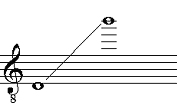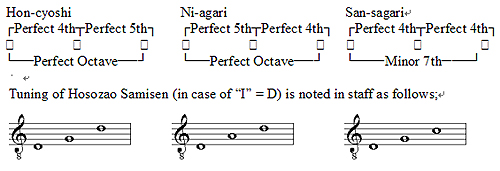Shamisen is categorized into the "Lute-family" instrument,
has long neck, three strings, and no frets. The neck is connected
into the body, which covered with stretched skin of dogs or cats.
We can play it with a large plectrum.
In Japan, there are many varieties of shamisen. Each type of Shamisen
has the different size of neck and body. In this section, we will
explain about "Hosozao Shamisen (a thin neck Shamisen)"
and "Hutozao Shamisen (a thick neck samisen)", which ordinarily
used in ensemble of us; Pro Musica Nipponia.
[Tuning
and the range of tone]
Each strings of Shamisen called "I (one)"-"II (two)"-"III
(three)" from the string of lower tone. We don't tune it in
absolute pitch. In the case of "Hosozao Shamisen", the
"I" string is tuned from H to D (When the tension of string
is loosed, it can sound smaller volume tone. Oppositely, when strongly
tightened, it may snap.) Otherwise, In the case of "Hutozao
Shamisen", the "I" string is tuned from G to A. (It
is common that the tuning tones of Shamisen are noted in staff with
"8" under G-Clef)
| Hosozao Shamisen |
Hutozao Shamisen |
 |
 |
The range of tone is about as follows;
| Hosozao Shamisen |
Hutozao Shamisen |
 |
 |
When we play traditional Japanese music, we ordinarily use the tuning
styles named "Hon-cyoshi", "Ni-agari", and "San-sagari".
In these styles, as every string is tuned to harmonic overtone,
they harmonizes each other in natural. When we play modern music,
we seldom use the tuning style with Augment 4th. Though we can change
the tuning of shamisen in the middle of music, it takes a few minutes
to make the tone steady.

[Playing Techniques]
1. Left-Hands Techniques
(1) Hajiki Filliping with left-hand's fingers, without a plectrum
(2) Suri, Koki Moving the left-hand's finger, in order to change
the remains of tone.
(3) Uchi Tapping on the string with left-hand's fingers.
(4)Ura-hajiki Filliping the string with left-hand's three fingers.

2. Right-Hands Techniques
(1)(Ordinary performing)
Striking a string downward with a plectrum.
(2)Sukui
Picking a string up from the surface of body with a plectrum. (We
can play a sound like tremolo, when we repeat quickly striking it
down and picking up. But it's not easy to play)
(3)Pizzicato
Flipping a string with a right-hand finger without a plectrum. (It's
noted as "pizz.")
(4)Kokashi
Sliding a plectrum on strings quickly.

3. Both-Hands Techniques
(1) Sukui + Hajiki
Striking a string downward with a plectrum, then picking it up,
and then flipping it with a left-hand finger. We often use this
technique for fast passage.
(2) Kokashi + Hajiki
Striking two strings downward with a plectrum, then flipping one
with a left-hand finger. After that we can pick it up.
(3) Kakebachi
Flipping a string with a left-hand finger, while muting its sound
by pressing a plectrum on the string.

4. Other notes about Shamisen
(1) Sawari
"Sawari" is a noisy sound we can hear
when we play "I" in open string. If we tune the "II"
or "III" string to harmonic overtone of "I"
string, it sounds when we play "II", "III" in
open string.
(2) Difficulty of Jumping tone
Shamisen has no fret and very long neck, it's difficult for us
to move the finger very wide position. When we play a fast passage,
open strings are very useful.
(3) Performing multi-tones
It's difficult to use two or more positions on Shamisen's strings.
Otherwise, it's easy to play multi tones with open strings.
(We can sound double-stop, only in slow tempo, and using neat
position on the neck.)
|



